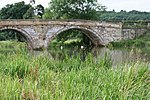Castle Howard railway station

Castle Howard railway station was a minor railway station serving the village of Welburn and the stately home at Castle Howard in North Yorkshire, England. On the York to Scarborough Line it was opened on 5 July 1845 by the York and North Midland Railway. The architect was George Townsend Andrews. It closed to passenger traffic on 22 September 1930 but continued to be staffed until the 1950s for small volumes of freight and parcels.The station was often used by the aristocracy, notably Queen Victoria when she visited Castle Howard with Prince Albert as a guest of Earl of Carlisle in August 1850. The station is now a private residence.Castle Howard station was featured in the British TV documentary The Architecture the Railways Built presented by historian Tim Dunn on Yesterday in 2020.
Excerpt from the Wikipedia article Castle Howard railway station (License: CC BY-SA 3.0, Authors, Images).Castle Howard railway station
Castle Howard Station Road, York Welburn
Geographical coordinates (GPS) Address Nearby Places Show on map
Geographical coordinates (GPS)
| Latitude | Longitude |
|---|---|
| N 54.091 ° | E -0.87488 ° |
Address
Castle Howard Station
Castle Howard Station Road
YO60 7EW York, Welburn
England, United Kingdom
Open on Google Maps











